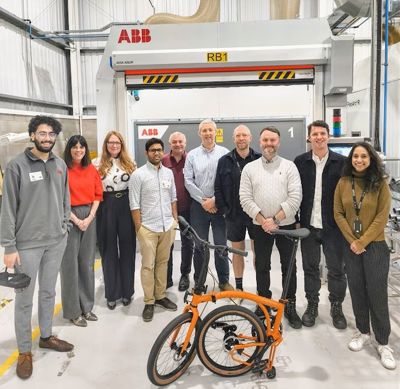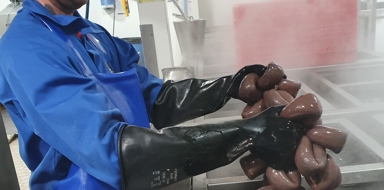
A bike manufacturer has used a ground-breaking collaboration to make a significant leap toward smart, scalable, and sustainable production.
Brompton Bikes, the UK's largest bicycle manufacturer, partnered with ABB Robotics, a global leader in industrial automation and robotics, East Kent College (EKCG), a collective of six community-based colleges, HSSMI, a sustainable manufacturing consultancy, on a R&D project backed by Made Smarter Innovation.
Innovation Case Study - Brompton BikesThe Brom-bot project developed solutions which reduce emissions, enhance efficiency, and future-proof production.
Chris Needham, Innovation Lead for Made Smarter Innovation, said: “Brompton’s Brom-bot project perfectly captures what Made Smarter Innovation aims to achieve: bold thinking, real-world collaboration, and meaningful impact. By combining advanced robotics with a people-first approach, this project has delivered a step change in productivity, sustainability, and skills development.”
The Inspiration
Brompton Bikes, the UK’s largest bicycle manufacturer, is renowned for its iconic foldable bikes. With rising global demand, the company plans to double production to 140,000 bikes annually by 2027, through a new high-tech factory in Ashford, Kent.
To support this growth, Brompton is embracing robotics and automation to boost productivity, quality, and sustainability. This transition also offers a chance to rethink operations, upskill the workforce, and design a factory that aligns with its B Corp sustainability goals.
However, automating complex tasks like brazing and coating poses significant challenges due to the bikes’ intricate design and the current reliance on skilled manual labour. A shortage of workers trained in robotics further complicates the shift.
To address these hurdles, Brompton has partnered with ABB Robotics, East Kent Colleges Group (EKCG), and HSSMI.
The Innovation
The Brom-bot project was structured into four phases: developing robotic solutions for specific technical challenges, pilot testing, planning integration into Brompton’s new factory, and supporting staff upskilling.
One of the first tasks on the project was to review which operations at Brompton were most suitable for robotic integration. The team began by mapping the company’s manufacturing processes and used a scoring matrix to identify automation opportunities, prioritising labour-intensive tasks such as brazing and coating.
To establish an accurate baseline for Brompton’s manufacturing facility, the team used specialist camera equipment from EKC Group to perform detailed 3D scans of the Greenford site. With limited CAD assets available, these scans generated a high-resolution point cloud, which was converted into solid surfaces using 3D Studio Max software. The resulting digital twin, accurate to within 1mm, was integrated into 2D and 3D modelling environments to simulate and de-risk automation designs, optimise layouts, and detect potential clashes. This model proved vital in adapting robotic solutions to fit seamlessly within the existing facility.
Next, the team collaborated with ABB to develop robotic solutions for coating and brazing operations. For coating, they created a system combining a novel end effector for consistent paint application, advanced programming to coordinate subsystems, and a compact cell design.
Simultaneously, they developed a robotic brazing solution capable of matching manual quality and strength while ensuring repeatability and scalability. Key developments included custom jigs, GD&T compliance, and a new quality standard. ABB’s RobotStudio was used to digitally refine the process - adjusting the setup, wire, and torch parameters - achieving a breakthrough in robotic brazing quality.
After pilot testing at ABB, robotic cells were installed in a ‘sandpit’ at Brompton’s Greenford R&D centre to refine the systems and identify new automation opportunities.
Once the robotic solutions had been prototyped and tested, the team explored how they could be scaled and integrated into Brompton’s Greenford facility and the future Ashford site. Using the 3D digital twin developed earlier, they built a simulation model to design the robotic production environment virtually. This helped identify potential design issues early, reducing risk and cost. Various production scenarios and shift patterns were modelled to detect bottlenecks and points of starvation, ensuring the robotic workflows could be balanced and optimised ahead of real-world deployment.
To upskill personnel and ensure operators could work confidently alongside robotics and new technologies, the team developed an Augmented Reality (AR) application tailored to the brazing solution. Using Microsoft HoloLens and ABB’s OptiFact system, the application presents real-time and static data in an immersive format, aiding training, programming, safety, diagnostics, and decision-making.
The Impact
The Brom-bot project has delivered significant value to Brompton Bikes and its partners, driving advancements in automation, workforce development, and sustainability.
For Brompton, the project provided a clearer understanding of which operations can be automated. Two robotic solutions were developed for coating and brazing, with plans to refine and deploy them in production.
The automated brazing process is 30% faster than manual methods, improving scalability and reducing lead times.
These innovations will be extended to other brazing operations, such as those involving handlebars and frames, helping to automate manual processes and improve efficiency.
Across both robotic solutions, the process reduces energy consumption and emissions, with an estimated 15-20% reduction in environmental impact. This builds on Brompton’s broader mission to increase urban mobility and reduce traffic and emissions.
During the project, Brompton’s workers were upskilled to manage and program robots, resulting in greater job satisfaction and enhanced job security. This shift sets a strong cultural foundation for the new Ashford factory, which is expected to create 500 highly skilled jobs and generate up to three times that number across the wider supply chain.
For ABB, the project led to the creation of robotic solutions that achieve high-quality results in both coating and brazing. These insights are now being explored for application in other sectors.
Through this project 22 T-Level students from EKCG gained hands-on experience in automation design and problem-solving. The group has now successfully updated its curriculum to include digitalisation and automation, equipping students with industry-relevant skills.
Riddhi Karambelkar, Head of Manufacturing Engineering for Brompton Bikes, said: “Working with ABB, EKCG, and HSSMI has opened our eyes to what’s truly possible when engineering talent, education, and technology come together with a shared purpose. This project has transformed not just how we work, but how we think about the future of bike manufacturing.
“The Made Smarter Innovation programme didn’t just fund technology, it helped unlock our potential as a forward-thinking manufacturer. It’s the kind of investment that pays off for industry, people, and the planet.”





